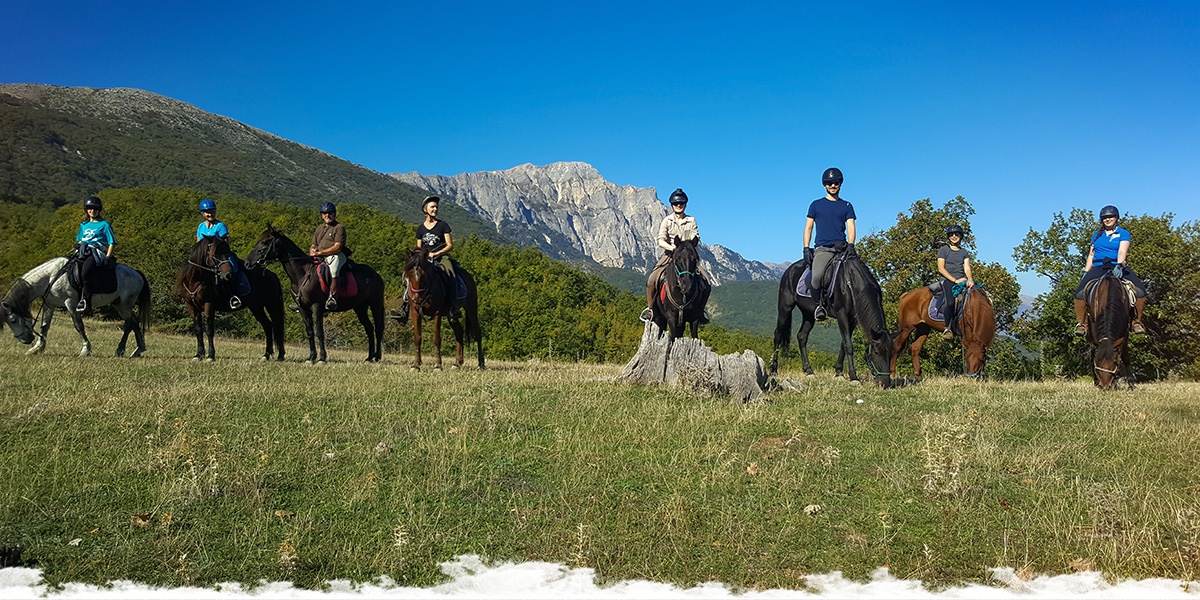
A taste of Albania
In October 2019, Equus team member Iris visited our partners in Albania and joined one of the last trail rides of the season (Ancient Mountain Trails). These are her impressions from this trail, taking place in the mountains near Gjirokastra, in the south.
***
"One raki a day keeps the
doctor away". This unconventional twist on a popular saying is brought to
you by Aurel, one of our guides on our trail ride across the mountains of
Albania. To his credit - it seems to be working. He spills the last drops onto
his hands and rubs the alcohol away, leaving only the smell of grapes. A habit
he learned from making raki with his father. In rural Albania, almost every
family make their own raki - something they are very proud of. It will be
offered several times throughout the day: when you get back from your ride, in
the evening after dinner, and even at breakfast. Over the course of the week we
would learn the stories of our host families, raki and all.
A FIRST TASTE OF ALBANIA
Our own story starts in Gjirokastra.
This small medieval city located in the south of Albania (roughly a 4-hour
drive from the country's only airport) is also a UNESCO world heritage site. It
is perched on the side of a mountain, dominated by an imposing fortress. The
castle is open to visitors and is well worth a visit. After a long car transfer
from Tirana, my friend and I enjoy stretching our legs as we explore the town's
small winding streets and bazaar, taking in the vibrant local atmosphere. Our hotel is a
little out of the way, in a more modern part of the town. This is where we meet our group for the week. There's
seven of us - an auspicious number - all coming from across the world. Dinner
gives us our first taste of the local cuisine: plates of food are brought for
us to share, meats and vegetables a-plenty, lovely local wine, and of course...
raki. All delicious, and in more than generous quantities. Dinner is our chance
to get acquainted, and also to meet our guides and the owners of the stables;
which is one of the two only equestrian centres in the country.
Kristina, Ilir and Aurel are the
most gracious hosts, entertaining us with stories about their horses and telling
us more about what's on the cards for the week ahead. Kristina takes the time
to ask us about our riding preferences before she gives us the name of our
horses. Names are an important matter: the foals aren't named immediately after they are
born. Instead, the team let their personality develop before they can give them
a name. Socrates is a philosopher at heart. Propus has a lovely, round, uphill
canter. I'm given Hektor, and told he is as brave as the Greek hero. Kristina
also says he is a "very serious" horse. I'm a little bit puzzled by
this, but I guess it is for me to find out (Will he wear glasses and a moustache?
Does he stay home on a Friday night? Does that mean he doesn't like raki?!).
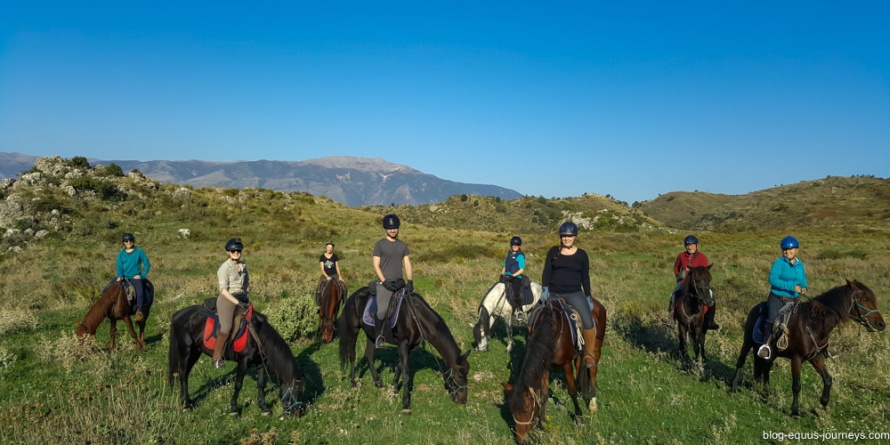
OFF ON A RIDING ADVENTURE
The skies are blue as we arrive at
the stables the following morning. The forecast for the week is excellent.
There should be no rain at all and the temperatures should stay at a pleasant
25°C. We can't believe our luck as the end of October is usually rainy and much
colder. Another good omen.
The horses are all lined up and
waiting for us, under the watchful eye of the stables vet (yes, they have their
own vet!). I meet my serious horse - he looks at me and tolerates a cuddle.
Olti, our back-up guide extraordinaire, helps me get on and makes some last
minute checks. And just like that, we are off on an adventure.
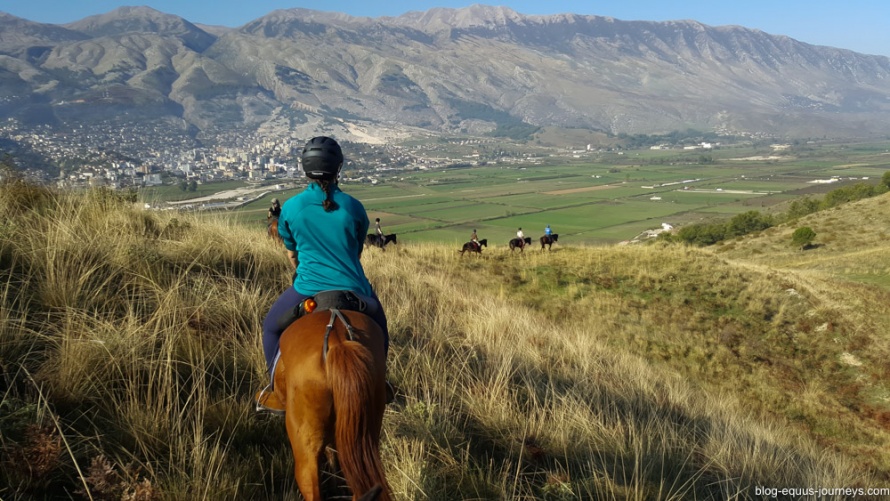
Kristina sets the pace for the week.
She has three gears: steady when climbing, fast pretty much everywhere else, and
very fast whenever she can - and sometimes even when you think she can't. That
is our first impression as European and North American riders: are we really
going to canter along that steep, narrow, stony path?! Yes, we are. And guess
what... It's all fine. My horse is like nothing I've ever ridden. He's fast and
energetic. But most of all, I don't believe I ever got to ride a horse quite
this sure-footed. He finds his way across the most difficult paths with
disconcerting ease. Loose stones, steps, and cracks on the road are no bother
to him. I soon realise every horse in our group is the same. They are all from
a local breed, which was slowly disappearing before the team started a
conservation programme. They are small and strong: we are told it's a cross
between Tarpans and Arabians brought over by the Ottomans. After a week of
scrambling up and down the mountains, I'd be willing to bet there is a wild
goat streak in there somewhere too... The team breed their own horses and as a
result, most of them are young. Hektor is only five, but fearless and loves his
job. Sometimes his enthusiasm goes a little bit over the top and we disagree on
a few things. His name marks him as brave and a fighter, after all - he is
happier leading the charge - but I know I can trust him to carry me safely
across mountains, over rivers and into deep valleys. After just a day, I know
what Kristina meant by a "serious" horse.
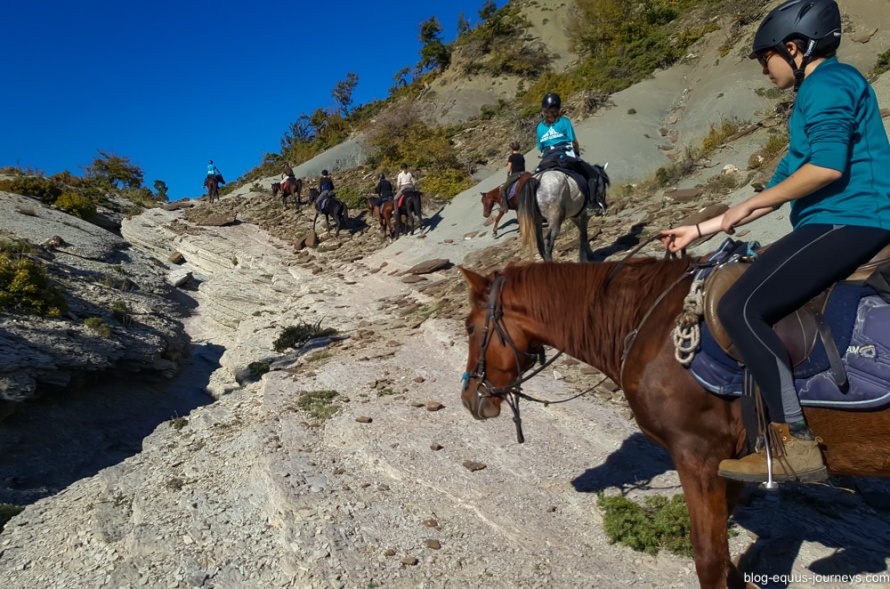
ALONG OLD CARAVAN PATHWAYS
All the horses are shod front and
back in a way I've never seen before: a full plate with a curved spike over the
heel, held in place by three nails on each side. It is unusual, but it does a
great job at keeping the stones out. These special shoes prove quite useful.
Most of the trail takes us over the ancient pathways built by Ali Pasha so that
caravans of Ottoman merchants could drive their wares from village to village.
Under the small hooves of our horses, we distinguish old roads and loose
pavement stones. An impressive feat of construction, sadly left to fall into
ruins for a lack of conservation budget. The same is happening to the Byzantine
and Paleo Christian churches we get to see during the week. Although some
effort is made by the locals to preserve this stunning heritage, there is more
to be done - hopefully before it's too late, and before time and rivers wash it
all away. One notable exception is an impressive bridge standing proud over the
Zagora river, an impressive structure that we cross on horseback, trying to
keep our horses dead straight in the middle of it (parapets are for the weak). Another
example is the church in the village of Labovë, that we get to visit with our
guide while the horses enjoy a break.
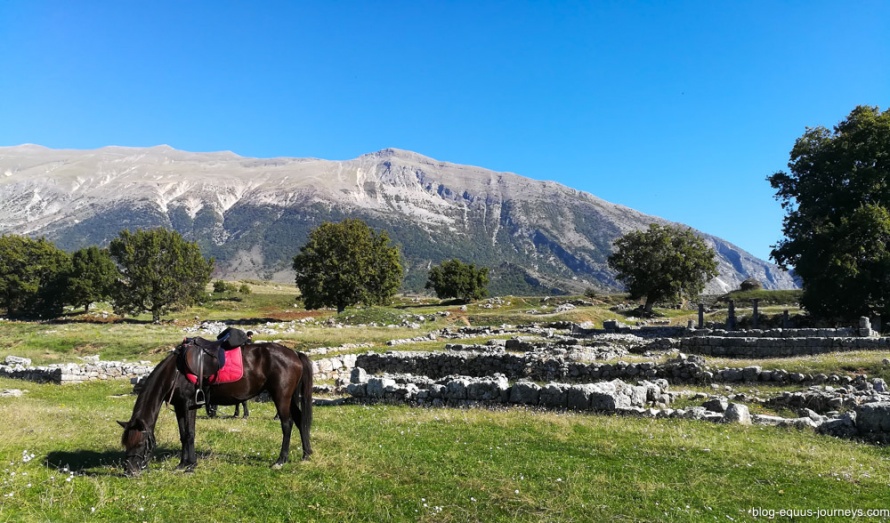
These old, decrepit caravan pathways
make for a rocky climb over the mountains. The horses don't seem to mind, they
know the trail and this is their home. Kristina tells us you can trust a horse
in its environment, and these prove to us time and time again that we can trust
them in theirs. Some of these ascents and descents are dizzying and you
certainly need to have a good head for heights, especially towards the end of
the week. The views, however, are worth it, and we take it all in as our horses
catch a well-deserved break.
AN ATHLETIC TRAIL IN THE MOUNTAINS
There is more to this trail than
going up and down, up and down. Sure, it makes for a good part of it, but we
also ride in sheltered valleys that offer narrow grassy plains where we can
give our horses their heads. If we thought they were fast over stony tracks, we
really get an idea of their full potential in the valleys. Michael & Mavri, Maciej & Sacha, and Hektor and I zoom in behind Kristina or Aurel. The rest
of our group... Well, let's just say they do their best to keep up!
The riding is surprisingly fast for
a mountainous trail ride. The canters are never really long but frequent. The
trots are sparse - I am not complaining, although Hektor's walk is nice and
active and he's got a comfortable smooth canter, I'm afraid his trot is the
exact opposite!
Every day, one of us gets up early
to check on the horses and feed them grain. It is one of the features of this
trail that we are responsible for the horses at night - it's an adventure, not
a relaxing holiday. In the evenings, we give them oats, hay and water.
Headtorch recommended. At 8:30 am we are usually on horseback, ready for around
4-6 hours in the saddle. Lunches are simple picnics, either brought to us by
the back up vehicle or packed in your saddlebags. It's simple but effective
after a full morning of riding: eggs, tomatoes, byrek (filo pastry pies, normally
stuffed with spinach and cheese), olives, bread and feta cheese. We eat sitting
on the ground by a river, on makeshift stone tables and chairs by an old mill,
at a table near a shepherd's hut... One day, one of the shepherds treats us to
fresh yoghurt, cheese and butter. Earlier during the week, as we were still
close to civilization, we stopped at a cafe to try a dish of aubergines slowly
cooked with tomatoes and onions. Simply delicious!
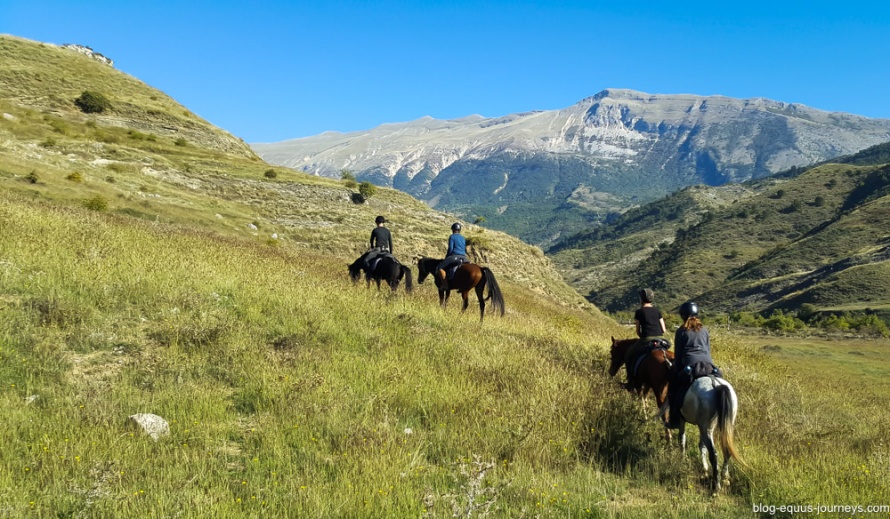
LIFE IN ALBANIA
The evenings are spent with local
families. They welcome us into their homes with open arms and enough food to
feed three times our group. Oh, and did I mention raki...? There's homemade
wine too, of mixed quality but always abundant quantities. Our hosts don't
speak much English. Some of them, none at all. We soon learn that it doesn't
really matter, as long as you can master the basics. One to remember is
"Gëzuar" (cheers). A simple word that we used very frequently... And with a little sign language, a little French, a little Russian and a
little Italian, and a few old photo albums, we puzzled the pieces of their
stories together. They are not always joyful. You have to remember that Albania
was a dictatorship and a communist state until the implosion of the USSR in
1991. In many ways, the country still bears the scars of that time. You see it
in old bunkers built to face the "imaginary enemy", that were
ultimately never used. You see it in the lack of infrastructure and desperately
low wages. You see it in the smiles and genuine warmth of the people, who want
nothing more than to share a little bit of their life and positivity with you.
We stayed with people whose stories really touched us. Whether learning
traditional dances in front of an abandoned school in a village where there are
no more children, sharing a cup of tea looking at old family pictures, or
learning about the sacrifices a young man made to be with the woman he loved,
we made memories that will stay with us for a long time, beyond the riding
experience. It is a simple life they live, especially in the most remote areas
where villages are nothing more than a few houses bundled together. And we
couldn't help but think there's a lesson to be learnt somewhere.
I'm lucky enough to say I've been on
a few of these riding trips by now, and each was special and unique in its own
way. But this ride offers something that not many riding holidays can provide:
a real human, cultural and historical experience.
In a few words...
Who is this for: Riders with a keen sense of adventure and a positive
attitude. A good sense of humour and open mind are a must. Must be willing to
sacrifice the comforts of modern amenities and some privacy for a week. This is
not a luxury riding holiday!
Experience levels? Open to intermediate levels as some of the horses are
easy to ride, but you must be comfortable in the saddle and fit. The riding can
be a little technical at times and there are a couple of gallops. Some descents
are very steep and you will need to dismount and lead your horse on foot.
Good to know: There are no single rooms and you are expected to look after
the horses in the evenings and mornings.
Top tips: Do some research on the country and learn some basic Albanian words. It
shows you care!
Last minute packing considerations: a headtorch to feed the horses in the evenings when
the days are getting shorter. Some pictures or your family and hometown to show
your hosts.
Also: the same team runs a different trail ride heading west towards the sea:
Sea and Mountains of Albania. It offers a little more variety in the scenery
but is physically more challenging and reserved to experienced riders.
More information
For more information, please visit our website: please take a look at our trail rides in Albania. You can also contact us directly at info@equus-journeys.com or give us a call on +44 (0)1905 388 977
